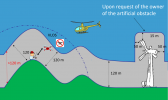I live in South Wales UK and I have been flying for a number of years and my last drone was the Mavic Pro.
I bought the new Mini 3 Pro and the RC controller about 2 weeks ago and I have to say what a fantastic package it is.
I find it brilliant to fly with some superb features however; I wonder how seriously the CAA are expecting us to be able to fly legally.
The problems I have found with regards to that is that flying the mini within the confines of direct site. Obviously the Mavic, being larger was easier to see however, because the mini is smaller, I sometimes find it difficult to re-sight it, if I momentarily glance down at the screen to change a parameter. I then have to fly it POV until I can find it again. I don’t have problems with my eyesight before anyone asks.
The second issue is that according to the rules, we must maintain the 400 feet limit over any point on the ground. Where I live it is full of mountains and valleys so it is VERY difficult to know the height of the drone over any of the lower points as the altimeter on the controller only gives the height over the home point.
I do hope they don’t expect rigid adherence to the drone laws and would accept a certain amount of discretion in it’s enforcement.
I bought the new Mini 3 Pro and the RC controller about 2 weeks ago and I have to say what a fantastic package it is.
I find it brilliant to fly with some superb features however; I wonder how seriously the CAA are expecting us to be able to fly legally.
The problems I have found with regards to that is that flying the mini within the confines of direct site. Obviously the Mavic, being larger was easier to see however, because the mini is smaller, I sometimes find it difficult to re-sight it, if I momentarily glance down at the screen to change a parameter. I then have to fly it POV until I can find it again. I don’t have problems with my eyesight before anyone asks.
The second issue is that according to the rules, we must maintain the 400 feet limit over any point on the ground. Where I live it is full of mountains and valleys so it is VERY difficult to know the height of the drone over any of the lower points as the altimeter on the controller only gives the height over the home point.
I do hope they don’t expect rigid adherence to the drone laws and would accept a certain amount of discretion in it’s enforcement.










